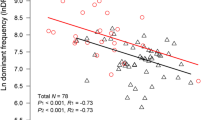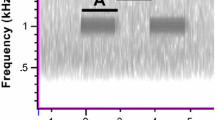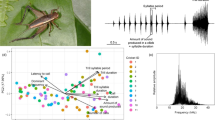Abstract
Acoustically active animals may show long- and short-term adaptations in acoustic traits for coping with ambient noise. Given the key role of calls in anurans’ life history, long- and short-term adaptations are expected in species inhabiting noisy habitats. However, to disentangle such adaptations is a difficult task, incipiently addressed for Neotropical frogs. We investigated if males of a stream-breeding frog (Crossodactylus schmidti) adjust call traits according to the background noise, and if the signal-to-noise ratio (SNR) varies between call harmonics and along call notes. We measured sound pressure levels of calls and noise in the field and used a fine-scale acoustic analysis to describe the signal and noise structure and test for noise-related call adjustments. The multi-note harmonic call of C. schmidti greatly varied in the spectral structure, including a trend for increasing note amplitude along the call, a wide frequency bandwidth of the 2nd harmonic, a minor call frequency modulation due to a trend for increasing note frequency within the same harmonic, and a major call frequency modulation due to the variable location of the dominant harmonic along the call. Calls had significantly higher frequencies than the noise at the range of the 1st and the 2nd call harmonics, and significantly louder sound pressure than the noise at the range of all harmonics. Males emitted the majority of call notes showing positive SNR, and though males also emitted some notes with negative SNR, when a given harmonic was negative the other harmonics in the same note did not tend to be SNR-negative. Our results indicate that male C. schmidti show short-term acoustic adjustments that make the advertisement call effective for coping with the interference of the stream-generated noise. We suggest that the call spectral plasticity serves for coping with temporary changes in the background noise, whilst we also discuss the possibility that the redundant, harmonic-structured call may have evolved to diminish masking interference on the acoustic signal by the background noise. This is the first study to uncouple noise-related acoustic adjustments and putative long-term acoustic adaptations for a Hylodidae, providing insights on behavioral plasticity and signal evolution of stream-breeding frogs.





Similar content being viewed by others
References
Bee MA (2004) Sound ruler acoustical analysis: a free, open code, multi-platform sound analysis and graphing package. Bioacoustics 14:171–178
Boeckle M, Preininger D, Hödl W (2009) Communication in noisy environments I: acoustic signals of Staurois latopalmatus Boulenger 1887. Herpetologica 65:154–165. doi:10.1655/07-071R1.1
Bosch J, De la Riva I (2004) Are frog calls modulated by the environment? An analysis with anuran species from Bolivia. Can J Zool 82:880–888. doi:10.1139/Z04-060
Both C, Grant T (2012) Biological invasions and the acoustic niche: the effect of bullfrog calls on the acoustic signals of white-banded tree frogs. Biol Lett 8:714–716. doi:10.1098/rsbl.2012.0412
Brumm H, Slabbekoorn H (2005) Acoustic communication in noise. Adv Study Behav 35:151–209. doi:10.1016/S0065-3454(05)35004-2
Brumm H, Zollinger SA (2013) Avian vocal production in noise. In: Brumm H (ed) Anim. Commun. noise. Springer-Verlag, Berlin Heidelberg, pp. 187–227
Brumm H, Zollinger SA (2011) The evolution of the Lombard effect: 100 years of psychoacoustic research. Behaviour 148:1173–1198. doi:10.1163/000579511X605759
Caldart VM, Iop S, Cechin SZ (2011) Vocalizations of Crossodactylus schmidti Gallardo, 1961 (Anura, Hylodidae): advertisement call and aggressive call. North West J Zool 7:118–124
Caldart VM, Iop S, Cechin SZ (2014) Social interactions in a neotropical stream frog reveal a complex repertoire of visual signals and the use of multimodal communication. Behaviour 151:719–739. doi:10.1163/1568539X-00003165
Caldart VM, Iop S, FP d S, et al. (2013) New records of Crossodactylus schmidti Gallardo, 1961 (Anura: Hylodidae) for the state of Rio Grande do Sul, Brazil, with data on morphometry and an updated geographic distribution map. Check List 9:1552–1555
Cunnington GM, Fahrig L (2010) Plasticity in the vocalizations of anurans in response to traffic noise. Acta Oecol 36:463–470. doi:10.1016/j.actao.2010.06.002
Endler JA (1992) Signals, signal conditions, and the direction of evolution. Am Nat 139:S125–S153. doi:10.1086/285308
Endler JA (1993) Some general comments on the evolution and design of animal communication systems. Philos Trans R Soc Lond Ser B Biol Sci 340:215–225. doi:10.1098/rstb.1993.0060
Feng AS, Narins PM, Xu C-H, et al. (2006) Ultrasonic communication in frogs. Nature 440:333–336. doi:10.1038/nature04416
Frost DR (2015) Amphibian species of the world: an online reference. Version 6.0. In: Am. Museum Nat. Hist. New York. http://research.amnh.org/herpetology/amphibia/index.html
Gerhardt HC (1991) Female mate choice in treefrogs: static and dynamic acoustic criteria. Anim Behav 42:615–635. doi:10.1016/S0003-3472(05)80245-3
Gingras B, Boeckle M, Herbst CT, Fitch WT (2013) Call acoustics reflect body size across four clades of anurans. J Zool 289:143–150. doi:10.1111/j.1469-7998.2012.00973.x
Goutte S, Dubois A, Legendre F (2013) The importance of ambient sound level to characterise anuran habitat. PLoS One 8:e78020. doi:10.1371/journal.pone.0078020
Grafe TU, Preininger D, Sztatecsny M, et al. (2012) Multimodal communication in a noisy environment: a case study of the Bornean rock frog Staurois parvus. PLoS One 7:e37965. doi:10.1371/journal.pone.0037965
Grafe TU, Wanger TC (2007) Multimodal signaling in male and female foot-flagging frogs Staurois guttatus (Ranidae): an alerting function of calling. Ethology 113:772–781. doi:10.1111/j.1439-0310.2007.01378.x
Gridi-Papp M (2004) SoundRuler: acoustic analysis for research and teaching
Haddad CFB, Giaretta AA (1999) Visual and acoustic communication in the brazilian torrent frog, Hylodes asper (Anura: Leptodactylidae). Herpetologica 55:324–333
Halfwerk W, Lea AM, Guerra MA, Page RA, Ryan MJ (2015) Vocal responses to noise reveal the presence of the Lombard effect in a frog. Behav Ecol. doi:10.1093/beheco/arv204
Hammer Ø, Harper DAT, Ryan PD (2001) PAST: paleontological statistics software package for education and data analysis. Paleontol Electron 4:1–9
Hart PJ, Hall R, Ray W, et al. (2015) Cicadas impact bird communication in a noisy tropical rainforest. Behav Ecol. doi:10.1093/beheco/arv018
Hartmann MT, Giasson LOM, Hartmann PA, Haddad CFB (2005) Visual communication in Brazilian species of anurans from the Atlantic forest. J Nat Hist 39:1675–1685. doi:10.1080/00222930400008744
Heyer WR, Rand AS, Cruz CAG, et al. (1990) Frogs of Boracéia. Arq Zool 31:231–410. doi:10.2307/1446606
Hödl W, Amézquita A (2001) Visual signalling in anuran amphibians. In: Ryan MJ (ed) Anuran Commun. Smithsonian Institution Press, Washington, DC., pp 121–141
Hutter CR, Esobar-Lasso S, Rojas-Morales JA, et al. (2013) The territoriality, vocalizations and aggressive interactions of the red-spotted glassfrog, Nymphargus grandisonae, Cochran and Goin, 1970 (Anura: Centrolenidae). J Nat Hist 47:3011–3032. doi:10.1080/00222933.2013.792961
Iop S, Caldart VM, dos Santos TG, Cechin SZ (2011) Anurans of Turvo State Park: testing the validity of seasonal Forest as a new biome in Brazil. J Nat Hist 45:2443–2461. doi:10.1080/00222933.2011.596951
Kaefer IL, Lima AP (2012) Sexual signals of the Amazonian frog Allobates paleovarzensis: geographic variation and stereotypy of acoustic traits. Behaviour 149:15–33. doi:10.1163/156853912X623757
Larom D, Garstang M, Payne K, et al. (1997) The influence of surface atmospheric conditions on the range and area reached by animal vocalizations. J Exp Biol 200:421–431
Ligges U, Krey S, Mersmann O, Schnackenberg S (2013) tuneR: Analysis of music. URL: http://r-forge.r-project.org/projects/tuner/
Lingnau R, Bastos RP (2007) Vocalizations of the Brazilian torrent frog Hylodes heyeri (Anura: Hylodidae): repertoire and influence of air temperature on advertisement call variation. J Nat Hist 41:1227–1235. doi:10.1080/00222930701395626
Love EK, Bee MA (2010) An experimental test of noise-dependent voice amplitude regulation in Cope’s grey treefrog (Hyla chrysoscelis). Anim Behav 80:509–515. doi:10.1016/j.anbehav. 2010.05.031
Maluf JRT (2000) Nova classificação climática do Estado do Rio Grande do Sul. Rev Bras Agrometeorol 8:141–150
Moiron M, González-Lagos C, Slabbekoorn H, Sol D (2015) Singing in the city: high song frequencies are no guarantee for urban success in birds. Behav Ecol. doi:10.1093/beheco/arv026
Narins PM, Feng AS, Lin W, et al. (2004) Old World frog and bird vocalizations contain prominent ultrasonic harmonics. J Acoust Soc Am 115:910–913
Oliveira-Filho AT, Jarenkow JA, Rodal MJN (2006) Floristic relationships of seasonally dry forests of Eastern South America based on tree species distribution patterns. In: Pennington RT, Lewis GP, Ratter J (eds) Neotrop. savannas Seas. dry For. plant Divers. Biogeogr. Conserv. Taylor & Francis/CRC Press, Boca Raton, FL, pp. 151–184
Pimenta BVS, Wachlevski M, Cruz CAG (2008) Morphological and acoustical variation, geographic distribution, and conservation status of the spinythumb frog Crossodactylus bokermanni Caramaschi and Sazima, 1985 (Anura, Hylodidae). J Herpetol 42:481–492
Preininger D, Boeckle M, Freudmann A, Starnberger I, Sztatecsny M, Hödl W (2013) Multimodal signaling in the small torrent frog (Micrixalus saxicola) in a complex acoustic environment. Behav Ecol Sociobiol 67:1449–1456. doi:10.1007/s00265-013-1489-6
R Development Core Team (2011) R: a language and environment for statistical computing, version 2.12.2
Ríos-Chelén AA, Lee GC, Patricelli GL (2015) Anthropogenic noise is associated with changes in acoustic but not visual signals in red-winged blackbirds. Behav Ecol Sociobiol. doi:10.1007/s00265-015-1928-7
Röhr DL, Paterno GB, Camurugi F, Juncá FA, Garda (2015) Background noise as a selective pressure: stream-breeding anurans call at higher frequencies. Org Divers Evol 16:269–273
Rundus AS, Hart LA (2002) Overview: animal acoustic communication and the role of the physical environment. J Comp Psychol 116:120–122. doi:10.1037/0735-7036.116.2.120
Schwartz JJ, Bee MA (2013) Anuran acoustic signal production in noisy environments. In: Brumm H (ed) Anim. Commun. noise. Springer-Verlag, Berlin Heidelberg, pp. 91–132
Seger-Fullam KD, Rodewald AD, Soha JA (2011) Urban noise predicts song frequency in northern cardinals and American Robins. Bioacoustics 20:267–276
SEMA Secretaria Estadual do Meio Ambiente (2005) Plano de Manejo do Parque Estadual do Turvo. Porto Alegre, Estado do Rio Grande do Sul: [s.n.], 348 p.
Shieh B-S, Liang SH, Chen CC, et al. (2012) Acoustic adaptations to anthropogenic noise in the cicada Cryptotympana takasagona Kato (Hemiptera: Cicadidae). Acta Ethol 15:33–38. doi:10.1007/s10211-011-0105-x
Silva R, Martins I, Rossa-Feres D (2008) Bioacústica e sítio de vocalização em taxocenoses de anuros de área aberta no noroeste paulista. Biota Neotrop 8:123–134
Sueur J, Aubin T, Simonis C (2008) Seewave: a free modular tool for sound analysis and synthesis. Bioacoustics 18:213–226
Tárano Z, Fuenmayor E (2013) Mate choice based on acoustic features in Johnstone’s whistling frog Eleutherodactylus johnstonei: an experimental approach. South Am J Herpetol 8:52–59. doi:10.2994/SAJH-D-12-00016.1
Tárano Z, Herrera EA (2003) Female preferences for call traits and male mating success in the neotropical frog Physalaemus enesefae. Ethology 109:121–134. doi:10.1046/j.1439-0310.2003.00848.x
Vargas-Salinas F, Amézquita A (2013) Abiotic noise, call frequency and stream-breeding anuran assemblages. Evol Ecol 28:341–359. doi:10.1007/s10682-013-9675-6
Vargas-Salinas F, Dorado-Correa A, Amézquita A (2014) Microclimate and stream noise predict geographic divergence in the auditory signal of a threatened poison frog. Biotropica 46:748–755. doi:10.1111/btp.12169
Vélez A, Schwartz JJ, Bee MA (2013) Anuran acoustic signal perception in noisy environments. In: Brumm H (ed) Anim. Commun. noise. Springer-Verlag, Berlin Heidelberg, pp. 133–185
Vielliard JME, Cardoso AJ (1996) Adaptação de sinais sonoros de anfíbios e aves a ambientes de riachos com corredeiras. In Herpetologia neotropical. In: Pefaur JE (ed) Acta Del II Congr. Lat. Am. Herpetol. Univ. Los Andes. Consejo de Desarrolo, Humanistico y Tecnológico, Merida, Venezuela, pp 97–119
Wells KD (1977) The social behaviour of anuran amphibians. Anim Behav 25:666–693
Wells KD (2007) The ecology and behavior of amphibians. University of Chicago Press, Chicago and London
Wiley RH (2009) Trade-offs in the design of experiments. J Comp Psychol 123:447–449. doi:10.1037/a0016094
Wiley RH (2003) Is there an ideal behavioural experiment? Anim Behav 66:585–588. doi:10.1006/anbe.2003.2231
Wiley RH, Richards DG (1978) Physical constraints on acoustic communication in the atmosphere: implications for the evolution of animal vocalizations. Behav Ecol Sociobiol 3:69–94. doi:10.1007/BF00300047
Zar JH (1999) Biostatistical analysis, 4 edn. Prentice Hall, Jersey
Acknowledgments
We are grateful to Camila Both, Cynthia Prado, Selvino Neckel de Oliveira, Sandro Santos and two anonymous referees for their reviews that further improved the manuscript. Thanks are also due to Doris Preininger for kindly discussing the bioacoustic procedure of signal-to-noise analysis, and to the staff of the Laboratório de Herpetologia – UFSM for their assistance in field activities. V.M.C. and S.I. thank CAPES for the doctoral fellowships and S.Z.C. is grateful to CNPq for the award of a research fellowship (No. 304929/2012-3). Activities in Turvo State Park were performed in accordance with the access licenses (Nos 133/2010 and 23/2011) issued by SEMA-RS.
Author information
Authors and Affiliations
Corresponding author
Ethics declarations
Ethical approval
All applicable international, national, and/or institutional guidelines for the care and use of animals were followed. All procedures performed in studies involving animals were in accordance with the ethical standards of the institution or practice at which the studies were conducted.
Conflict of interest
The authors declare that they have no conflict of interest.
Rights and permissions
About this article
Cite this article
Caldart, V.M., Iop, S., Lingnau, R. et al. Communication in a noisy environment: short-term acoustic adjustments and the underlying acoustic niche of a Neotropical stream-breeding frog. acta ethol 19, 151–162 (2016). https://doi.org/10.1007/s10211-016-0235-2
Received:
Revised:
Accepted:
Published:
Issue Date:
DOI: https://doi.org/10.1007/s10211-016-0235-2




